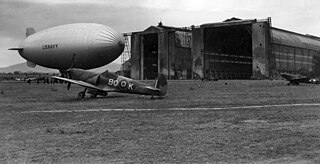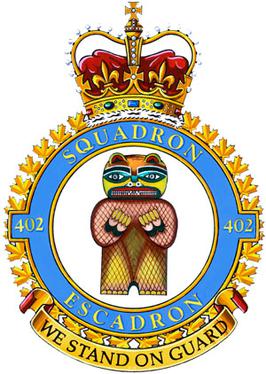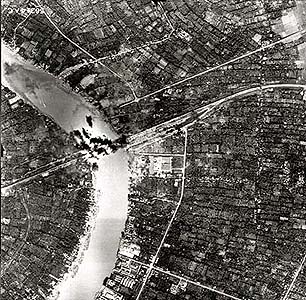
The former Royal Air Force Far East Air Force, more simply known as RAF Far East Air Force, was the Command organisation that controlled all Royal Air Force assets in the east of Asia. It was originally formed as Air Command, South East Asia in 1943 during the Second World War. In 1946, this was renamed RAF Air Command Far East, and finally Far East Air Force in June 1949.

The RAF Third Tactical Air Force, which was formed in South Asia in December 1943, was one of three tactical air forces formed by the Royal Air Force (RAF) during the Second World War. It was made up of squadrons and personnel from the RAF, Indian Air Force (IAF) and the air forces of other Commonwealth countries. Third TAF was formed shortly after the establishment of South East Asia Command to provide close air support to the Fourteenth Army.

Number 17 Squadron, currently No. 17 Test and Evaluation Squadron (TES), is a squadron of the Royal Air Force. It was reformed on 12 April 2013 at Edwards Air Force Base, California, as the Operational Evaluation Unit (OEU) for the Lockheed Martin F-35B Lightning.

No. 20 Squadron is the Royal Air Force's Operational Conversion Unit (OCU) for ground-based Tactical Air Command and Control, and Air Battle Management. It is part of the RAF's Air Surveillance and Control System (ASACS) and is based at RAF Boulmer. It was allocated the role on 1 June 2021.

No. 211 Squadron RAF was a squadron in the Royal Air Force active from 1917 to 1919 and from 1937 to 1946. In World War I it operated as a bomber and later a reconnaissance unit on the Western Front. In World War II it operated as a medium bomber unit in the Middle East and Far East and later as a strike fighter unit in the Far East, equipped with, successively, the Bristol Blenheim, the Bristol Beaufighter and de Havilland Mosquito.

No. 451 Squadron was a Royal Australian Air Force army cooperation and fighter squadron of World War II. It was formed at Bankstown, New South Wales, on 12 February 1941 and began flying operations on 1 July as part of the North African Campaign in Egypt and Libya. No. 451 Squadron was withdrawn for refitting in early January 1942 and spent the remainder of the year performing garrison duties in Syria. In January 1943, it was transferred to Egypt to contribute to local air defence but saw almost no combat. This inactivity caused morale among the squadron's personnel to greatly deteriorate.

402 "City of Winnipeg" Squadron is a Royal Canadian Air Force squadron based in Winnipeg, Manitoba, Canada

No. 457 Squadron was a Royal Australian Air Force (RAAF) fighter squadron of World War II. Equipped with Supermarine Spitfire fighters, it was formed in England during June 1941 under Article XV of the Empire Air Training Scheme. The squadron was transferred to Australia in June 1942 and saw combat in the South West Pacific Area before being disbanded in November 1945.

No. 60 Squadron of the Royal Air Force was formed in 1916 at Gosport. It is currently part of No. 1 Flying Training School based at RAF Shawbury in Shropshire flying the Airbus H135 Juno HT.1.
No. 4 Squadron IAF (Oorials) is a fighter squadron of the Indian Air Force (IAF) equipped with the Su-30 MKI, based at Jodhpur Air Force Station in Jodhpur in, Rajasthan, India. Since its establishment during the South-East Asian theatre of World War II, No. 4 Squadron remains the only fighter squadron other than No. 3 Squadron IAF and No. 7 Squadron IAF to remain continuously in existence in the service of India.

No. 611 Squadron is a British Royal Air Force squadron. It was first formed in 1936 and was disbanded in 1957 after seeing combat as a fighter unit during the Second World War. It was reformed as a reserve squadron in 2013.

The Supermarine Spitfire, the only British fighter to be manufactured before, during and after the Second World War, was designed as a short-range fighter capable of defending Britain from bomber attack and achieved legendary status fulfilling this role during the Battle of Britain. According to fighter ace J.E. "Johnnie" Johnson it was the best conventional defensive fighter of the war.
No. 268 Squadron RAF was a Royal Air Force squadron raised during the First World War and in the Second World War operated the North American P-51 Mustang on tactical reconnaissance missions over occupied Europe and in support of the D-Day landings.

No. 351 Squadron RAF was a Yugoslav Partisan-manned fighter-bomber squadron of the Royal Air Force (RAF) which was operational between 13 October 1944 and 1 May 1945 during World War II. The squadron was also known by the Partisans as Second Squadron (NOVJ).
No. 136 Squadron RAF was a short-lived RAF unit that saw no action in World War I, but upon reformation became the highest scoring unit in South East Asia Command during World War II. Shortly after the war the squadron was disbanded.

No. 421 Squadron RCAF was a unit of the Royal Canadian Air Force. It was the last RCAF fighter squadron to be formed in the UK during World War II.

No. 130 Squadron of the Royal Air Force was a Second World War and Cold War fighter squadron, and later a strategic missile squadron.
No. 124 (Baroda) Squadron RAF was a Royal Air Force Squadron formed to be a light bomber unit in World War I and reformed as a fighter unit in World War II.

7 Squadron was a unit of the South African Air Force which served in the Second World War as well as in South Africa between 1951 and 1992. During the war, the squadron was used as a fighter squadron deployed to the Western Desert as well as in the Aegean, Italy and Ceylon. The squadron was inactive from the end of the war until 1951 when it re-activated as a citizen force training squadron, a role it retained during two periods of active service until 1992, when it was disbanded for the last time.

The city of Bangkok, Thailand was bombed by the Allies on numerous occasions during World War II. It was also the target for the first combat mission by Boeing B-29 Superfortresses in June 1944.
















